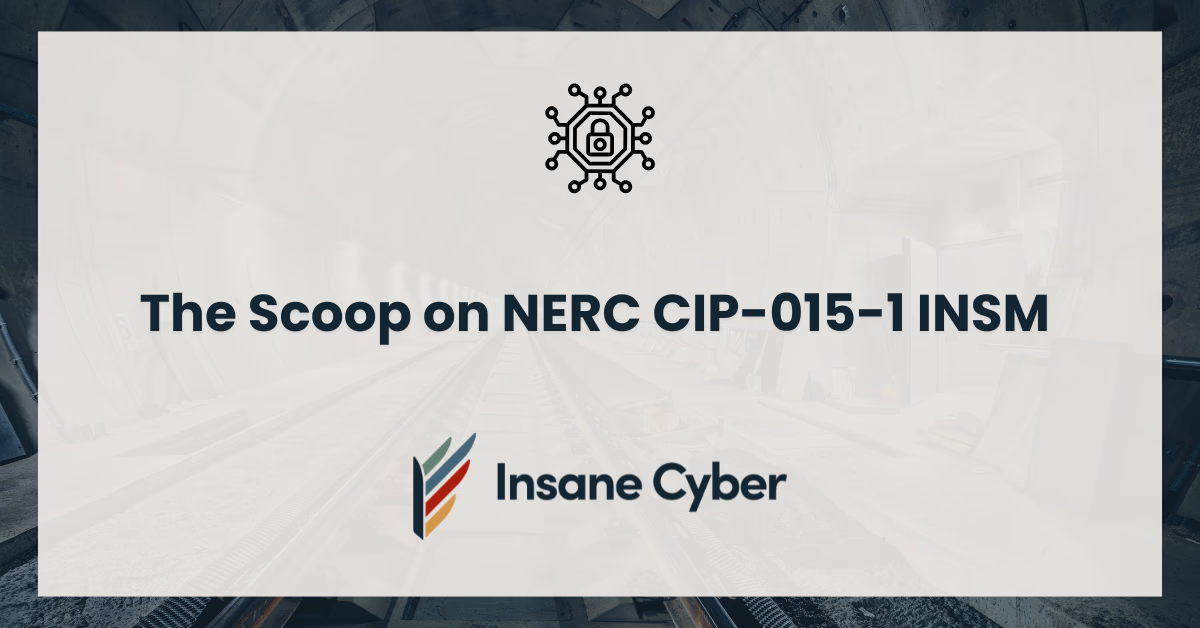Unpacking NERC CIP-015-1: Why Internal Network Security Monitoring is Your Next Big Focus
If you’ve got your ear to the ground, you’ve likely heard the buzz around NERC CIP-015-1 and Internal Network Security Monitoring (INSM). It’s more than just another acronym to learn; it’s a significant shift in how we need to think about protecting our critical infrastructure. Let’s break down what this means for you, without the jargon headache.
Beyond the Perimeter: Understanding Internal Network Security Monitoring (INSM)
For years, the cybersecurity mantra often revolved around fortifying the perimeter – building strong walls to keep the bad guys out. But what happens when a threat slips through the cracks, or worse, originates from within? That’s where Internal Network Security Monitoring (INSM) steps into the limelight.
Think of INSM as your internal surveillance system. It’s the continuous watch over network traffic inside your trusted security zones. Its job? To spot and help you react to malicious activity that traditional perimeter defenses might miss. After high-profile incidents like the SolarWinds compromise, where supply chain vulnerabilities led to deep infiltration, regulators are understandably keen on bolstering visibility within our networks.
INSM vs. Traditional Monitoring: Spotting the Sneaky “East-West” Traffic
So, how is INSM different from what you might already be doing?
Traditional network monitoring typically keeps an eye on “North-South” traffic. This is the data flowing in and out of your network – picture cars entering and exiting a city via main highways. It’s crucial for seeing threats trying to cross your borders, like traffic moving between levels in the Purdue Model or passing through firewalls.
However, this leaves a hefty blind spot: “East-West” traffic. This is the communication happening within the same security zone – think of it as vehicles moving between different neighborhoods inside the city, never hitting the main highways. INSM specifically targets this internal chatter, helping you detect suspicious lateral movements or threats that are already quietly exploring your environment.
To get an even clearer picture, many organizations are also wisely pairing INSM with non-intrusive endpoint security solutions, especially in Operational Technology (OT) environments. These can shed light on tricky areas like device-to-device chats, USB activity, or local user actions that network sensors alone might not catch.
By shifting focus from just the gates to the entire internal landscape, INSM provides that critical layer of insight.
Why NERC CIP is Embracing INSM
In the world of the North American Electric Reliability Corporation (NERC) Critical Infrastructure Protection (CIP) standards, existing rules like CIP-005-7 do mandate monitoring network traffic at the Electronic Security Perimeter (ESP) for high- and medium-impact Bulk Electric System (BES) Cyber Systems. But here’s the catch: these standards haven’t fully addressed the gaps inside the ESP.
The Trouble with Signatures: Why Old Defenses Fall Short
Many current NERC CIP requirements, like those in CIP-005-7 and CIP-007-6, have leaned on tools such as traditional intrusion detection systems and anti-virus software. These primarily use signature-based detection. Imagine this as a security guard with a list of known troublemakers; if someone matches a description on the list, they’re flagged.
The problem? Attackers are smart. They’re constantly cooking up new methods designed to waltz right past these signature-based checks. Since at least 2018, adversaries have been actively working to disguise their malicious activities. Once a threat bypasses your perimeter firewall, these older technologies often struggle to spot novel or sophisticated attacks, leaving your critical assets vulnerable. This growing gap is exactly why we need more robust internal monitoring.
Enter NERC CIP-015-1. In January 2023, the Federal Energy Regulatory Commission (FERC) told NERC to get INSM requirements baked into the CIP Reliability Standards. This new standard is aimed squarely at:
- High-impact BES Cyber Systems (whether they have External Routable Connectivity [ERC] or not).
- Medium-impact BES Cyber Systems that do have ERC.
NERC kicked off Project 2023-03 INSM to get this standard drafted.
Objective-Based: Flexibility in How You Secure
One of the interesting things about CIP-015-1 is its objective-based approach. Instead of giving a rigid, step-by-step “how-to” guide, it outlines the security outcomes you need to achieve – namely, effectively detecting and responding to suspicious activity inside your ESP.
This flexibility is a good thing! It means your organization can choose the INSM technologies, processes, and setups that best fit your unique network architecture, risk profile, and operational needs. You might opt for advanced network traffic analysis tools, leverage existing packet capture solutions, or mix and match techniques. The focus is on “what must be done,” not a one-size-fits-all “how to do it.”
What’s Next? INSM for EACMS and PACS
Hold on, the story doesn’t stop with BES Cyber Systems. FERC has signaled that INSM’s reach will expand. They’ve directed NERC to broaden INSM coverage to include Electronic Access Control or Monitoring Systems (EACMS) and Physical Access Control Systems (PACS), even if they’re outside the traditional ESP.
This means you’ll need to start thinking about monitoring requirements for any systems that control or monitor access to your critical environments. NERC has 12 months from when the final FERC rule becomes effective to deliver an updated standard reflecting this wider scope. So, start mapping your EACMS and PACS landscape now – they’re officially on the INSM radar.
Key Requirements of NERC CIP-015-1
The standard boils down to three main requirements:
R1: INSM Implementation – Seeing What’s Happening You’ll need to implement and document your INSM process for detecting and responding to anomalous activity within your ESPs. This involves:
-
Setting up network data feeds to monitor connections, devices, and communications.
-
Identifying and documenting the right places and methods for data collection, based on your risk assessment. You need visibility into all relevant connections and communications.
-
Having mechanisms to detect and respond to weird stuff.
-
The Power of Baselines: To spot “anomalous activity,” you first need to know what “normal” looks like. Establishing a clear network baseline is key. By understanding typical traffic patterns, you can quickly identify deviations that might signal an intrusion. This makes tools like IDS/IPS much more effective, as they can alert you when something strays from the ordinary. Plus, keeping traffic logs helps with incident response and figuring out what happened.
-
AI to the Rescue: AI-powered network monitoring is becoming a game-changer here. These systems use machine learning to analyze huge amounts of traffic, spotting patterns and deviations that could indicate known or even brand-new threats within your trusted zones. They help you detect stealthy behaviors and speed up response times.
-
Behavior vs. Signature: This brings us to behavior-based anomaly detection. Unlike signature-based tools (think Symantec, McAfee checking for known “fingerprints” of malware), behavior-based systems learn your network’s normal rhythm. If something out of the ordinary happens – unusual data transfers, odd login attempts – it flags it, even if it’s a never-before-seen threat. This is a crucial layer for modern defense.
-
Cutting Down on False Alarms: Nobody likes a system that cries wolf. To minimize false positives, calibrate your INSM systems using industry best practices relevant to your setup. This means learning from similar utilities, fine-tuning detection thresholds based on your normal traffic, and regularly updating your rules. Frameworks from NIST and the Center for Internet Security (CIS) can offer great guidance.
-
What Traffic to Watch? Remember that East-West traffic? INSM is all about getting visibility here, covering device-to-device communications inside a trusted zone, local chats that don’t cross the perimeter, and user activity within the ESP. While passive network monitoring is core, specialized endpoint agents (especially for OT) can complement this.
-
R2: INSM Data Retention – Keeping the Evidence You must document and keep records of any anomalous activity your INSM detects. This means:
- Having documented data retention policies.
- System-generated reports to prove you’re following them.
- Your retention process should ensure network communications data and metadata are kept in enough detail and for long enough to allow for proper analysis. While the exact timeframe isn’t set in stone (you have flexibility), consider leveraging existing incident investigation policies, possibly keeping high-value info longer. (This doesn’t apply during documented CIP Exceptional Circumstances, of course.)
R3: INSM Data Protection – Guarding the Guards Naturally, the INSM data you collect and retain needs protection against unauthorized deletion or changes. Evidence for this includes:
-
Security controls for stored data.
-
Access control policies to ensure data integrity.
- Dashboards and Reporting for Smooth Compliance: Tools that offer clear dashboards and reporting are invaluable for NERC CIP compliance. They centralize data, simplify tracking controls, and make evidence gathering for auditors much quicker. Advanced forensic capabilities also help you pinpoint root causes of incidents faster, aiding thorough investigations.
Timeline: When Do You Need to Comply?
Once CIP-015-1 gets the final nod from FERC (it was submitted for approval in July 2023 and is currently awaiting that decision), the clock starts ticking for entities like Balancing Authorities, Distribution Providers, Generator Operators & Owners, Reliability Coordinators, and Transmission Operators & Owners.
- 36 months to comply for all high- and medium-impact BES Cyber Systems with ERC.
- 60 months for all other medium-impact BES Cyber Systems with ERC. (The original text seems to have a slight redundancy here; generally, the timelines differentiate between high-impact systems and medium-impact systems, or between those with and without ERC. The provided text specifies “all other medium-impact BES Cyber Systems with ERC” for the 60-month timeline. We’ll stick to that phrasing but note it’s a bit unusual. The core idea is a phased rollout.)
The projected compliance deadline is hovering around late 2027, but this is subject to change based on FERC’s approval date.
Challenges to Tackle Now
Getting ready for INSM isn’t a flip-of-the-switch affair. Here are some hurdles to start thinking about:
-
Knowing Your Network:
- Asset Inventory: Can you identify and document all your Cyber Assets (hardware, software)?
- Network Architecture: Do you have a clear map of your network protocols and data flows? Consider if additional segmentation could make monitoring more effective.
- Asset Visibility & Vulnerability Assessment: A full inventory of Industrial Control System (ICS) assets is step one. Automated discovery tools can be a lifesaver. Follow this with comprehensive vulnerability assessments to find weaknesses. Prioritized, actionable remediation steps (patching, upgrades, configuration changes) help you close gaps efficiently.
-
Smart INSM Deployment:
- Where are the best spots to monitor for comprehensive visibility?
- Don’t forget data storage – you’ll need space for retained data.
-
Security and People Power:
-
Implement robust protections for your INSM data.
-
Train your cybersecurity teams to understand, deploy, and manage INSM effectively.
-
The Tricky Task of Network Baselining: Establishing accurate network baselines can be tough, especially across diverse environments like substations and control centers. Each has unique traffic patterns. “Normal” in a remote substation is very different from a busy control center. Challenges include varied data sources, defining what’s truly “anomalous” for each context, and the sheer labor involved (automation is your friend here!).
-
Final Thoughts: Get Ready for a More Resilient Future
NERC CIP-015-1 is a clear signal that the cybersecurity landscape for critical infrastructure is maturing. As threats get more sophisticated, robust INSM will be a cornerstone of better detection, faster response, and overall stronger resilience.
Don’t wait until the deadlines loom. Start assessing your network, exploring monitoring solutions, and evolving your cybersecurity strategy now. Proactive preparation will make the transition smoother and, more importantly, will genuinely strengthen your defenses.
Looking for a Path Through the INSM Maze?
The move towards comprehensive network security monitoring for BES Cyber Systems isn’t a surprise, given the history of cyber-attacks targeting the global electric sector. If you’re an asset owner wondering how to tackle INSM implementation or find monitoring solutions that align with NERC CIP-015-1, know that help is available.
Platforms like Valkyrie aim to simplify this with automated monitoring. They offer features like:
- Visualizing connected data points and data flows.
- Near real-time data analysis and reporting.
- Continuous monitoring of host and network data.
- Comprehensive asset visibility and vulnerability assessment, automatically identifying devices for a unified view.
- Actionable remediation insights, including patches and upgrades.
- AI-powered network monitoring to detect anomalous activity, even within trusted zones.
- Dashboards and forensic tools to simplify compliance reporting and incident response.
- Flexible data retention and secure sensor image backups.
Solutions like these can provide the clarity, speed, and compliance support needed to navigate the evolving regulatory landscape and keep your critical systems secure. If you’re charting your course for INSM, reaching out to specialists can make all the difference.
References
https://www.nerc.com/pa/Stand/Pages/Project%202016-02%20Modifications%20to%20CIP%20Standards.aspx
https://www.nerc.com/pa/Stand/Pages/Project-2023-03-INSM.aspx
https://www.nerc.com/pa/Stand/Pages/Project%202016-02%20Modifications%20to%20CIP%20Standards.aspx







